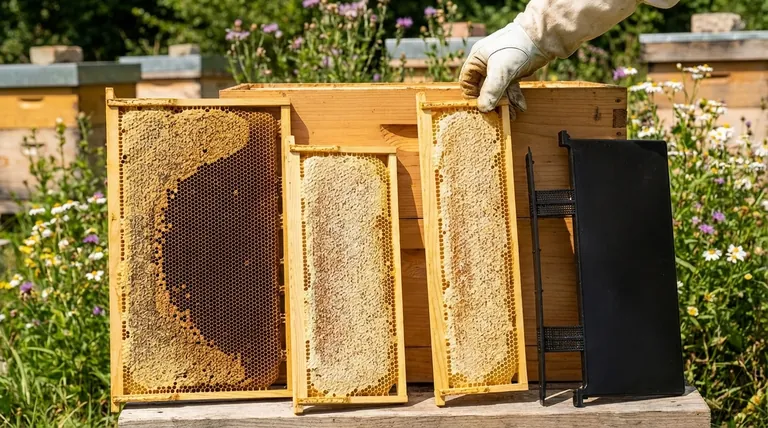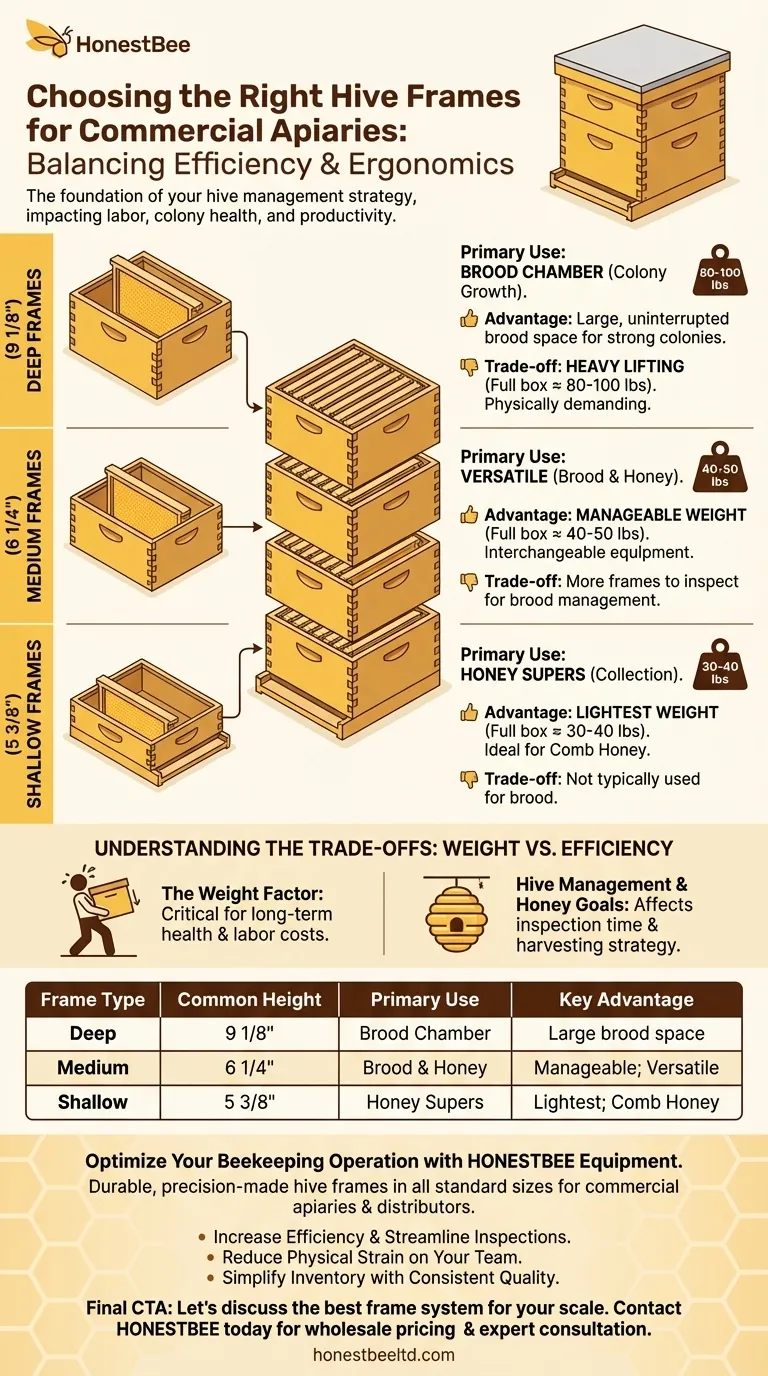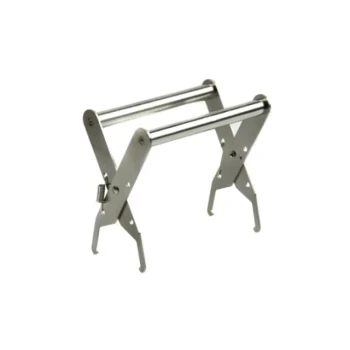The most common types of hive frames are categorized by their height, with the primary standards being Deep, Medium, and Shallow. The exact measurements for these can vary slightly, but they generally conform to Deep (9 1/8"), Medium (6 1/4"), and Shallow (5 3/8") sizes. These frames are designed to fit within corresponding hive boxes, or "supers," which typically hold 8 or 10 frames side-by-side.
Your choice of frame size is one of the most fundamental decisions in beekeeping. It directly impacts the weight you will have to lift, how your bees organize their colony, and the overall management strategy for your hives. The decision is a critical trade-off between hive efficiency and your physical comfort.

The Role of Frame Size in Hive Management
A hive frame provides the essential structure for bees to build their wax comb. Beekeepers install a sheet of foundation (either wax or plastic) into the frame, giving the bees a guide for drawing out the hexagonal cells used for raising brood and storing honey, pollen, and nectar.
The frame's height dictates the size of the box it fits into. A Deep frame goes in a Deep hive body, a Medium frame in a Medium super, and so on. Mismatching frames and boxes will create incorrect spacing, which the bees will fill with unwanted burr comb, making inspections difficult.
A Breakdown of Common Frame Sizes
While there are several specialty sizes, the vast majority of beekeeping operations are built around three standards.
Deep Frames (9 1/8")
This is the traditional and most common size for the brood chamber—the bottom boxes of the hive where the queen lays her eggs and the colony raises new bees.
A single deep frame provides a large, uninterrupted surface for the queen to establish her laying pattern. This can lead to a very strong and populous colony.
The major drawback is weight. A deep box full of brood, pollen, and honey can weigh 80-100 pounds, making it extremely difficult for many people to lift.
Medium Frames (6 1/4")
Medium frames are the most versatile option and are often used for both brood chambers and honey supers.
Using a single "all-medium" setup for the entire hive is a popular strategy. This simplifies your equipment needs, as every frame and every box is interchangeable.
A medium super full of honey weighs around 40-50 pounds—significantly more manageable than a deep. While it takes two medium boxes to approximate the brood space of one deep box, many find the lighter weight is a worthy trade-off.
Shallow Frames (5 3/8")
Shallow frames are almost exclusively used for honey supers, the boxes placed on top of the hive for honey collection.
Their primary advantage is their light weight. A full shallow super typically weighs 30-40 pounds, making it the easiest option to handle during honey harvest.
They are also the preferred size for producing comb honey, as the smaller frame is filled and capped more quickly and uniformly by the bees.
Non-Standard and Specialty Sizes
The references also list sizes like Super Deep (11 5/8") and Extra Shallow (4 3/4"). These are far less common and are typically used in specific beekeeping systems (like Dadant hives) or for specialized purposes. For most beekeepers, they are not a primary consideration.
Understanding the Trade-offs: Weight vs. Efficiency
Choosing a frame system is not about which is "best," but which is best for your specific goals and physical abilities.
The Weight Factor
This is the most critical consideration. A hive can grow to be very tall, and lifting heavy boxes is the most physically demanding part of beekeeping. If you have back problems or limited strength, using medium or shallow boxes instead of deeps is a crucial decision for your long-term enjoyment of the hobby.
Hive Inspection and Management
A brood chamber made of one deep box means you only have to inspect 8 or 10 large frames to find the queen and assess colony health.
A brood chamber made of two medium boxes means you have to inspect 16 or 20 smaller frames, which can take more time. However, the boxes themselves are lighter to separate and manipulate.
Honey Production Goals
If your goal is maximum honey volume with minimal equipment, deep frames can hold the most honey per frame.
If your goal is to harvest distinct nectar flows (e.g., a "spring wildflower" honey separate from a "summer clover" honey), the smaller medium or shallow supers are filled faster, allowing you to pull them off before the nectar source changes.
Choosing the Right Frame System for You
Your equipment should serve your beekeeping goals, not hinder them. Analyze your priorities to make a clear choice.
- If your primary focus is a traditional setup and you can handle heavy lifting: Use deep boxes for your brood chamber and medium or shallow boxes for your honey supers.
- If your primary focus is minimizing weight and simplifying equipment: Use medium boxes for the entire hive, for both brood and honey.
- If your primary focus is producing comb honey or keeping lifting to an absolute minimum: Use shallow boxes for your honey supers.
Ultimately, the best hive is the one you can manage effectively and safely for years to come.
Summary Table:
| Frame Type | Common Height | Primary Use | Key Advantage |
|---|---|---|---|
| Deep | 9 1/8" | Brood Chamber | Large, uninterrupted brood space |
| Medium | 6 1/4" | Brood & Honey (Versatile) | Manageable weight; interchangeable boxes |
| Shallow | 5 3/8" | Honey Supers | Lightest weight; ideal for comb honey |
Optimize Your Beekeeping Operation with the Right Equipment
Choosing the correct hive frames is fundamental to your apiary's productivity and your team's safety. HONESTBEE supplies durable, precision-made hive frames and beekeeping equipment in all standard sizes (Deep, Medium, Shallow) to meet the specific needs of commercial apiaries and beekeeping equipment distributors.
We help you:
- Increase Efficiency: Streamline hive inspections and honey harvesting with the right frame system.
- Reduce Physical Strain: Select from our range of lighter-weight options to protect your crew.
- Simplify Inventory: Our wholesale-focused operations ensure you get consistent, high-quality equipment.
Let's discuss the best frame system for your scale and goals. Contact HONESTBEE today for wholesale pricing and expert consultation.
Visual Guide

Related Products
- 3.5L Plastic Beehive Frame Feeder Deep Frame Water Feeder for In Hive Use
- Assembled Wooden Bee Frames with Beeswax Foundation Ready to Use by HONESTBEE
- Plastic Bee Frame Beekeeping Hive Frames for Wholesale
- HONESTBEE Wired and Assembled Wooden Bee Frames Foundation for a Thriving Hive
- Assembled Wooden Bee Frames with Plastic Foundation for Durability and Convenience by HONESTBEE
People Also Ask
- What is a frame feeder? A High-Capacity, Secure In-Hive Feeding Solution
- What are the types of internal feeders used in beekeeping? Optimize Your Hive's Nutrition Strategy
- What are frame feeders, and what are their advantages? Essential for Cold Weather & Efficient Feeding
- What are the advantages of frame feeders? Ensure Safe, In-Hive Feeding for Your Colony
- What are the advantages of using a frame feeder? Boost Hive Health with In-Hive Feeding



















